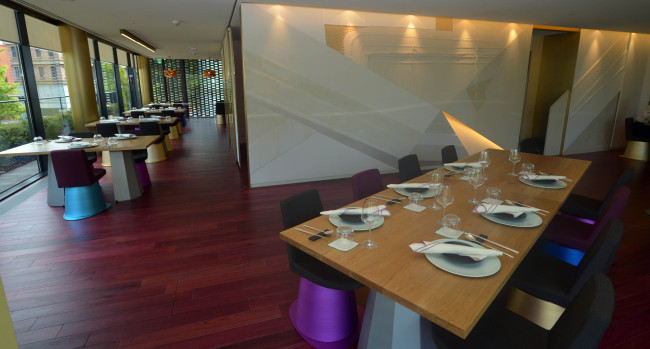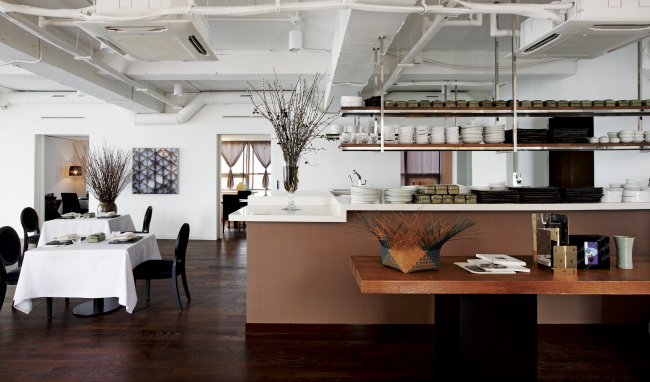Classics served up new
Modern Korean dining restaurants present unique twists on local cuisine
By Korea HeraldPublished : Aug. 23, 2013 - 20:11

At 10:30 a.m. on Wednesday, Bicena, a contemporary Korean restaurant in Hannam-dong, Seoul, is abuzz with staff preparing for the lunch guests. A woman places vases holding pastel-colored flowers on the tables, another is busy vacuuming a room. There is a din of activity in the kitchen.
Sitting at a table next to the kitchen entrance is a young woman poring over a pile of galley proofs ― Lucia Cho, president of Bicena, is proof reading the restaurant’s autumn menu.
If she looks a tad bit frazzled, that is understandable: Just that morning, she had a bit of a run-in with her father. Her father is none other than Cho Tae-kwon, CEO of KwangJuYo, maker of premium porcelain ware and premium soju, who is perhaps better known for being a tireless and passionate crusader for Korean food, or hansik.
“I do so much and still he says I don’t have enough passion,” Lucia says exasperated. Today she is going over the fall menu which will be launched Tuesday and preparing for an upcoming trip to Hawaii where her restaurant will be participating in the Hawaii Food & Wine Festival, Sept. 1-9. On top of that, she hosts a cooking show on a local cable television station. That seems to be a full plate for the 33-year-old restaurateur. “I am fortunate (to be where I am), but it is also a difficult position for someone my age,” Cho admits.
Bicena, opened May 2012, bills itself as a modern Korean dining restaurant. Whereas her father’s Gaon, now closed, sought to spearhead Korean fine dining in Korea, Lucia has set eyes on a different direction: modern Korean in an equally contemporary setting.
Gone are the starched, stiff white tablecloths. The chairs in bold colors of silver, gold and purple give the space a casual, yet luxurious feel. The Korean touches are so unobtrusive and modern that for someone who has just dropped in, it could look to be anything but a Korean restaurant.
The food at Bicena is on the somewhat showy side, too. The humble “mandu,” or dumplings, are presented in a fun way, each piece nestled within its own “spoon.” Thick slices of “dotorimuk,” or acorn jelly, lie hidden underneath a mass of greens and young ginseng roots topped with a flower, transforming the plain acorn jelly into a medley of flavors and textures.
What compelled a young woman who trained in art to start up a modern Korean dining restaurant?
“Why modern dining? Because I am modern, because it is something I can do,” Cho says. “It is not about ‘This is the right way for today.’ It is about reviewing the past. Because there is much information about the past, it could actually be easier to do something au courant,” she explains. “Take classical musicians for example. They work with the standard classical repertoire that is performed thousands of times. To become the best in that field is very difficult. The same goes for food.”
Having grown up abroad, she understands firsthand the needs of the foreign diners who make up some 40 percent of her customers.
“The main dish always features some carbs, in the form of barley or potato, for example, because foreigners do not eat rice that is part of ‘jinji,’” she says. “Jinji” is part of the meal that is served with a bowl of rice, soup and a few banchan, or side dishes. The restaurant also offers wine suggestions for each dish.
A very different mood prevails at Poom Seoul on Mt. Namsan in Hannam-dong. It is calm, with the many fine porcelain wares on display around the open kitchen and the gorgeous mother-of-pearl inlay armoire giving a Korean flair to the space.
Here, Han Bok-jin, an intangible cultural property titleholder in Joseon period royal cuisine, uses the most prized and fresh seasonal ingredients to reinterpret meals once served at Joseon nobilities’ homes for the contemporary times.
Reflecting the refined lifestyle of the Joseon-period upper class, the food at Poom Seoul is mild and clean on the palate. The seasonings are delicate, allowing the main ingredients to speak for themselves. The presentations are elegant ― reflecting the mood of Joseon paintings ― and creative at the same time.
At Poom Seoul, only course menus are available ― designed so that the dishes complement each other.
Sitting at a table next to the kitchen entrance is a young woman poring over a pile of galley proofs ― Lucia Cho, president of Bicena, is proof reading the restaurant’s autumn menu.
If she looks a tad bit frazzled, that is understandable: Just that morning, she had a bit of a run-in with her father. Her father is none other than Cho Tae-kwon, CEO of KwangJuYo, maker of premium porcelain ware and premium soju, who is perhaps better known for being a tireless and passionate crusader for Korean food, or hansik.
“I do so much and still he says I don’t have enough passion,” Lucia says exasperated. Today she is going over the fall menu which will be launched Tuesday and preparing for an upcoming trip to Hawaii where her restaurant will be participating in the Hawaii Food & Wine Festival, Sept. 1-9. On top of that, she hosts a cooking show on a local cable television station. That seems to be a full plate for the 33-year-old restaurateur. “I am fortunate (to be where I am), but it is also a difficult position for someone my age,” Cho admits.
Bicena, opened May 2012, bills itself as a modern Korean dining restaurant. Whereas her father’s Gaon, now closed, sought to spearhead Korean fine dining in Korea, Lucia has set eyes on a different direction: modern Korean in an equally contemporary setting.
Gone are the starched, stiff white tablecloths. The chairs in bold colors of silver, gold and purple give the space a casual, yet luxurious feel. The Korean touches are so unobtrusive and modern that for someone who has just dropped in, it could look to be anything but a Korean restaurant.
The food at Bicena is on the somewhat showy side, too. The humble “mandu,” or dumplings, are presented in a fun way, each piece nestled within its own “spoon.” Thick slices of “dotorimuk,” or acorn jelly, lie hidden underneath a mass of greens and young ginseng roots topped with a flower, transforming the plain acorn jelly into a medley of flavors and textures.
What compelled a young woman who trained in art to start up a modern Korean dining restaurant?
“Why modern dining? Because I am modern, because it is something I can do,” Cho says. “It is not about ‘This is the right way for today.’ It is about reviewing the past. Because there is much information about the past, it could actually be easier to do something au courant,” she explains. “Take classical musicians for example. They work with the standard classical repertoire that is performed thousands of times. To become the best in that field is very difficult. The same goes for food.”
Having grown up abroad, she understands firsthand the needs of the foreign diners who make up some 40 percent of her customers.
“The main dish always features some carbs, in the form of barley or potato, for example, because foreigners do not eat rice that is part of ‘jinji,’” she says. “Jinji” is part of the meal that is served with a bowl of rice, soup and a few banchan, or side dishes. The restaurant also offers wine suggestions for each dish.
A very different mood prevails at Poom Seoul on Mt. Namsan in Hannam-dong. It is calm, with the many fine porcelain wares on display around the open kitchen and the gorgeous mother-of-pearl inlay armoire giving a Korean flair to the space.
Here, Han Bok-jin, an intangible cultural property titleholder in Joseon period royal cuisine, uses the most prized and fresh seasonal ingredients to reinterpret meals once served at Joseon nobilities’ homes for the contemporary times.
Reflecting the refined lifestyle of the Joseon-period upper class, the food at Poom Seoul is mild and clean on the palate. The seasonings are delicate, allowing the main ingredients to speak for themselves. The presentations are elegant ― reflecting the mood of Joseon paintings ― and creative at the same time.
At Poom Seoul, only course menus are available ― designed so that the dishes complement each other.

The cool, slightly tart and bitter imjasu-tang, a chilled broth with chicken, jujube and sesame seed aspic garnished with ginseng, pear and cucumber, is a perfect start to a meal that cleanses and cools the palate for the dishes that follow.
The seasonal croaker served as a pan-fried patty and presented in a beef broth is tender and mild tasting, appropriate as a precursor to the more robust taste of grilled pork marinated in onion juice and fish sauce that follows. Presented with ssamjang and greens, the thin slices of pork, grilled tender and slightly brown, are meant to be eaten as “ssam,” or wraps, the traditionally preferred way of eating grilled meat.

That same cut of pork with extensive marbling is served in a very different way across town at Jungsik in Sinsa-dong. Thick cubes of pork are first steamed and then baked ever so slightly, resulting in a delightful mouthful that is crunchy at the first bite and then melts on your tongue. The slightly salty and acidic sauce made with “jjangachi,” or vegetables pickled in soy sauce and vinegar mixture, helps to chase the slightly fatty taste of the pork.
Chef Yim Jung-sik’s concept for the 30-seat restaurant is “New Korean.” Indeed, the dishes on the tasting menu ― a menu where you choose an appetizer, rice or noodle dish, a main dish, and dessert ― and the choice menu, a fixed menu, are all new, unique creations.
Like nouvelle cuisine in the West, Jungsik’s New Korean breaks with the past. Yim uses ingredients not used in Korean dishes ― truffle oil in a medley of four mushrooms, foie gras in the noodle in duck-based broth dish, for example.
The creativity and inventiveness do not end with the ingredients and cooking methods; they extend to presentations. The dessert of dark chocolate mousse in the form of miniature “jangdok,” or covered earthenware container, topped with a lotus leaf with a single drop of dew is an amusing end to a meal that draws out conversations.
“I wanted to try new things. I wanted to open a high-end restaurant that was different from existing Korean restaurants,” said Yim speaking from New York in a phone interview with The Korea Herald. Having opened Jungsik in Tribeca, New York, in 2011, following the launch of Jungsik in Seoul in 2009, Yim now splits his time between Seoul and New York.
Jungsik in Tribeca last year received a Michelin star, an impressive feat for a restaurant so young and a fitting recognition of Yim’s creative cuisine.
While non-Koreans make up 80 percent of the diners in Tribeca, Yim finds that his approach is becoming more Korean.
“New Yorkers want more Korean character,” he said.
In response, he has created a steak using sesame oil and juice from kimchi as the sauce.
Jungsik Steak will be debuted in Seoul in the fall menu, according to Yim.
By Kim Hoo-ran (khooran@heraldcorp.com)
-
Articles by Korea Herald



![[Weekender] Geeks have never been so chic in Korea](http://res.heraldm.com/phpwas/restmb_idxmake.php?idx=644&simg=/content/image/2024/05/16/20240516050845_0.jpg&u=)


![[News Focus] Mystery deepens after hundreds of cat deaths in S. Korea](http://res.heraldm.com/phpwas/restmb_idxmake.php?idx=644&simg=/content/image/2024/05/17/20240517050800_0.jpg&u=)
![[Herald Interview] Byun Yo-han's 'unlikable' character is result of calculated acting](http://res.heraldm.com/phpwas/restmb_idxmake.php?idx=644&simg=/content/image/2024/05/16/20240516050855_0.jpg&u=)











